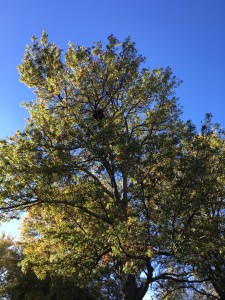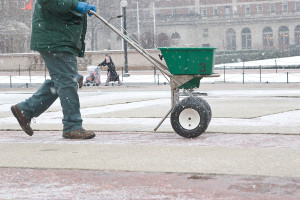Frost is a reality for many parts of the country. So, what can you do now and in the months to-come to keep your lawn healthy and ensure it bounces back quickly in the spring? That’s a question we hear asked frequently, so today we’re going to talk about lawn care do’s and don’ts as we move into early-winter.
We recently covered the topic of when to stop mowing for the season, so we’ll move one step beyond that and assume you’ve stopped mowing for the season (0r are close to stopping), and have applied fertilizer to the lawn. Any aeration and/or overseeding should also be done, or getting done well before the ground freezes.
Avoid Rodent-Related Drama
One consideration related to mowing however, is the importance of cutting your lawn short to minimize the possibility of animals using it for nesting ground. If you leave your grass long, mice and other small burrowing animals can dig in and build nests for shelter from winter’s cold.

Late-dropping trees such as the Pin Oak represent a unique yard clean-up challenge, as many of the leaves fall after the ground has frozen.
By the time spring rolls around, you can not only have significant patches of dead turf that’ll need to be reseeded, you’ll have a quickly growing population of small animals to deal with. Neither are appealing options, so just cut it short and virtually eliminate the possibility of it happening.
Remember the “Rule of 1/3”. It’s better to cut your lawn to its minimum length in stages, moving the mower deck down no more than 1/3 of the length of the grass blade with each cutting.
Late-Dropping Trees
A number of tree species drop their foliage late in the season, often after the ground has frozen and snow has fallen. And while it’s a good idea to eventually pick the leaf debris up, too much traffic on frozen turf grasses from feet or wheeled vehicles can kill the grasses.
Instead, pick a time when warmer weather causes a temporary thaw to get out and clean up the yard. Doing so will help to minimize moss and mold that can grow during above-freezing temperature in wet spots under fallen leaves.
If a thaw doesn’t happen, put leaf clean up on your list for early-spring.
The Effect of Salt on Your Lawn

The salt often used for de-icing driveways and sidewalks is especially tough on turf grasses. Photo: www.littlegreencloth.com
Road salt can damage or kill turf grasses. If the use of road salt is necessary for safety, be sure to minimize the amount of salt that gets broadcast onto the lawn, and regulate the amount applied to avoid oversalting. Sections of turf next to driveways and sidewalks are prime targets for salt-related damage, so use only the salt you need to ensure safety.
If you perpetually struggle with salt-related lawn damage each year, consider using a calcium chloride-based de-icing solution, which is less harmful to your lawn. You can also consult with a landscape professional to discuss landscaping solutions that can minimize the impact of de-icing operations on your lawn.
Other Winter Considerations
Keep sidewalks, driveways and paths clear of snow so pedestrians aren’t compelled to cut across the lawn and compact the turf grasses. As noted earlier, too much foot traffic increases turf stress and can even kill turf grasses, leading to brown spots or stripes that will require reseeding in the spring.
Winter is a great time to maintain your mower. Sharpen the blade(s), change oil, clean the air filter and do any other maintenance that needs to be done to your mower and other gasoline-powered lawn equipment. You can find maintenance schedules, parts numbers and other resources for your Exmark machine(s) at MyExmark.com. Next week, we’ll dive into winter mower maintenance in greater detail.
Of all the seasons, winter lawn maintenance is often the easiest. By following these few simple guidelines, you can give your lawn a great chance of bouncing back quickly and fully next spring. And, you’ll ensure your equipment is ready to roll when the spring thaw occurs.
References — For More Information
- “Tips for Winter Lawn Care“, LawnCare.org
- “Pin Oak Tree Guide“, Arbor Day Foundation
- “Lawn Care Calendar“, Cornell University
- “Top Fall Trees“, Arbor Day Foundation
- “Environmental, Health and Economic Impacts of Road Salt“, New Hampshire Department of Environmental Services
- “Road Salt Application and Storage“, United States Environmental Protection Agency (EPA)






